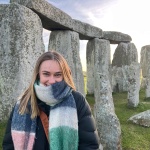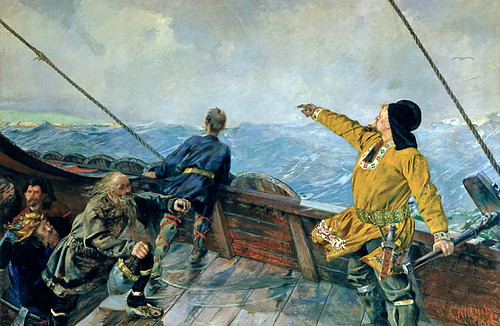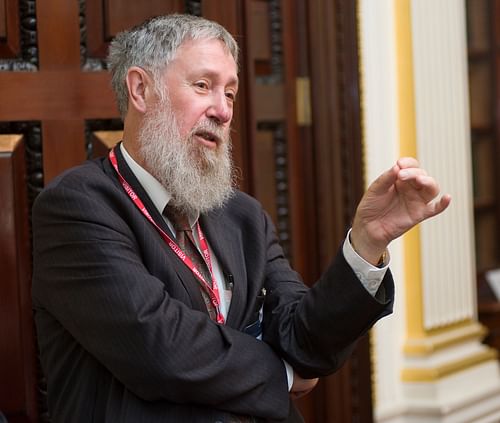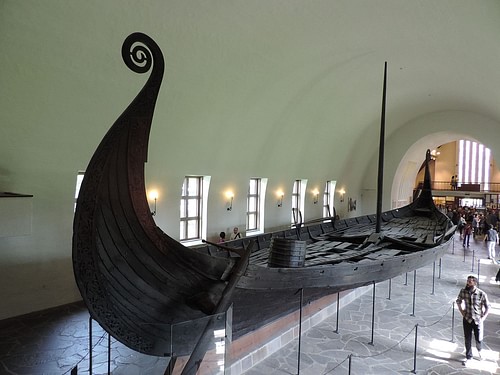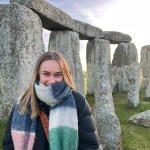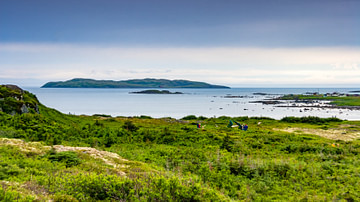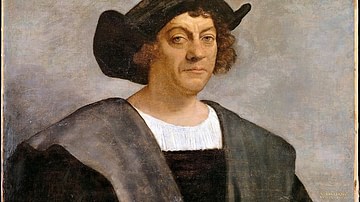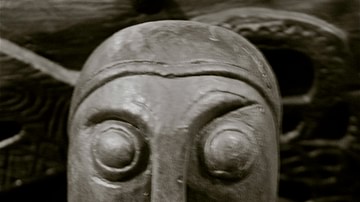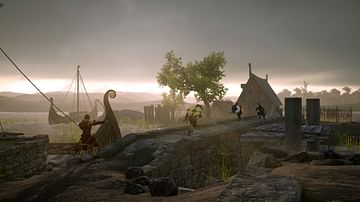In this interview, World History Encyclopedia talks to author and scholar Gordon Campbell all about his new book Norse America: The Story of a Founding Myth published by Oxford University Press.
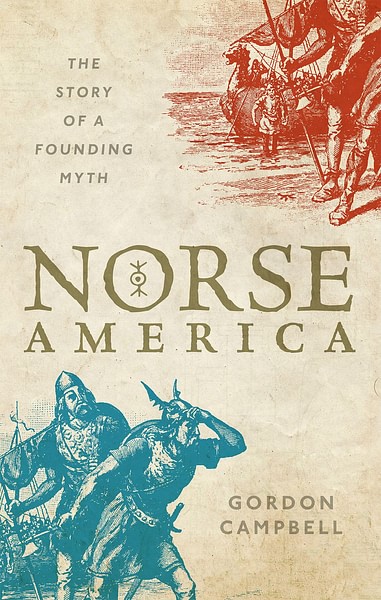
Kelly (WHE): Thanks for joining me today. Would you like to start off by telling us what your book is about?
Gordon Campbell (Author): Sure! It tells two stories. One story is that of the Norse proceeding in the 10th and 11th century from mainland Scandinavia to the Faroes and Iceland and Greenland, and from Greenland they sail, hunting in many cases to what is now the Eastern Arctic in Canada. And they famously, as we have known since the 1060s, had a sort of camp in Northern Newfoundland at a site called L'Anse aux Meadows. So that is one of the stories.
The other story is the appropriation of the first story by Canadians and Americans who want to have been discovered by people with white North European origins rather than by Columbus, who was Italian, sailed for Spain, and did all kinds of other suspicious things. So, there is a racial narrative, which is potentially pernicious in the huge attraction of having the Norse discover America. I became interested in the attraction as much as I did in the actual voyages themselves.
Kelly: I have never heard of a book that brings those two voyages together. So that is awesome.
Gordon: It all happened by accident! I was in Canada in the 1960s. I heard about the excavations in Newfoundland and the discovery of a Norse settlement. And then in the 70s, my first academic job was in Denmark. I became interested in the Northern world and the Norse. But what really sort of created the two stories was a day in Reykjavik in Iceland. I first went to the National Museum, a great place and all about Iceland, and not a word about Erik the Red and Leif the Lucky and Greenland and the discovery of America. Then I walked into town, and there in front of the National Cathedral is a huge statue of Leif the Lucky. I could not put these two together, and I walked around the back of the statue and it said, "a gift from the people of the United States of America". I realised at that point that Americans wanted to be discovered by the Norse, by the Icelanders, rather more than the Icelanders were interested in discovering America. It was that moment that made me realise there were two narratives here, and I had to somehow disentangle them.
Kelly: Was that a difficult job to disentangle them, or did you find it straightforward?
Gordon: It was a surprising job at several points. There was a site in Greenland, which was said to be the farm of Erik the Red, and I dutifully arrived at this expecting archaeological evidence of farming, which there is. But there on the hillside is a big statue of Leif Erikson erected by the Norwegian Society of Seattle and inaugurated with a choir that had flown in. It was an amazing moment, and I realized there was serious appropriation going on here. But it is, of course, denied by the Columbus people who rather oddly do not think of Greenland as part of North America. It is a sensitive issue because politically Greenland is an autonomous region of Denmark, but at the narrowest point, it is only separated from Canada by 16 miles. If you look at a map, anybody can see that it is clearly part of North America. But even though it was settled for hundreds of years by Norse that somehow does not count! Nothing counts until Columbus sails in 1492. I thought, what a wonderfully daft story.
Kelly: That's so interesting because I am pretty sure Christopher Columbus did not step foot in North America.
Gordon: He denied the existence of the New World. He insisted till his dying day that he had reached Asia. Of course, he was working in the Caribbean. He never envisaged North America, never thought it existed. And yet, he is the one who was appropriated. It is very odd, but once America became independent, they needed non-English origins. They somehow needed to push themselves away from wicked Britain and enter Columbus. And he was great for a while because he was deeply un-English. It is all about founding myths.
Kelly: What kind of sources did you use? Did you have physical artefacts to guide you on this disentangling?
Gordon: Yes, well the evidence that people want to use are the sagas. I do not assume that there is anything historical in the sagas. There might have been a chieftain called Erik the Red, but the notion that he had a son called Leif the Lucky seems to be far-fetched. These are not historical characters, but they are treated as such. Think of Schliemann's interest in the Iliad. He was sure that it was a true story and off he went to the coast of Turkey and excavated a site that he thought must be Troy. He found some burnt wood and he said, "AHA, this is it! This is the burning of the city." And he found various bits of gold and assembled them together and said it was Priam's treasure. And it is all made up. It is assuming that these ancient fictions are true and then getting evidence to substantiate it. There is that kind of evidence. The archaeological evidence, particularly in the United States and in maritime Canada, is all fake. In other words, if you are short of evidence, you manufacture it.
There are stones written with runic inscriptions on them. The most famous of them is called the Kensington Stone, which was found in 1898 in rural Minnesota. I have been to see it. The inscription says that in 1362, a group of Norsemen arrived here, they had a battle, and some of them were killed. It is the image of the savage indigenous people versus the noble Norse. Then they sailed away to their ships. It is bogus, but there are true believers in the Kensington Stone. There are also things that are misinterpreted. There are mounds in America and various places. The most recent ones I saw were in the upper Mississippi. They were made by indigenous people, but the myth is that they were made by Vikings because indigenous people are too simple – enter the racist stereotypes – to have done this kind of thing. Therefore, it must have been a superior civilisation, it must have been European. So, the evidence is a bit dodgy.
Kelly: So, there are all these fake artefactsd and then these new stories that have all been created just to substantiate what they believe and what they want to push.
Gordon: That is right. The one licit site outside Greenland – the Greenland sites are important and great fun, but the site that interests people because it's closer to the United States – is L'Anse aux Meadows. It has been recently dated by solar flares to 1021. It was a short-lived settlement, perhaps ten years, no longer. There are three huts for three boat crews. There are no burials, there is no church. It is clearly a shore station on the way to something. There is evidence of metalwork. There were nails made there. It is ship repair. Why was it there? Well, it seems to have been a sort of halfway house on the way to a short-lived colony somewhere on the coast of mainland North America.
Kelly: Right, so like a waystation kind of thing.
Gordon: Exactly right. After a few years, they shut up shop, though there is no evidence of contact there. They are all by themselves. But there are three butternut shells and, indeed, a bit of carved butternut. Now butternut has never grown in Newfoundland, does not grow in Newfoundland. It grows in the St. Lawrence Valley in Canada and on the coast of New England at the point where rivers come into the sea. The currents would not take these three butternuts to Newfoundland, they go in the wrong direction. So somehow the Norse acquired these three nuts. The simplest explanation of that is that they were on the North American mainland for whatever reason. But that is all the evidence there is.
Kelly: It is not huge, but it is also enough to believe that someone travelled from one place to another. That is the most logical explanation for the movement of the butternuts.
Gordon: That is precisely so.
Kelly: That is so fascinating. So, we do not know where they have come from or where they have gone.
Gordon: Nope! We do not know any of that. There is one genuine artefact in the States. It is called the Maine Penny in the state of Maine, and it was discovered in the 1950s, and it is a Norse coin from the 10th century. It is on an archaeological site that is arguably the densest site in the world. Something like 30,000 artefacts have been pulled out of it. It was a Native American site for centuries, and there is one coin. Now. There is no supporting evidence around it. And, of course, you can build a fantasy story about how the Norse arrived, and they traded the coin for whatever they were after. But there is an interesting thing about the coin, which was that on one side, a hole has been drilled, and that suggests it was a pendant. Coins would have no value, but it was worn as a pendant. It suggests a trade network that comes down from Labrador, passed from one indigenous group to another, and it ends up in this entirely indigenous site. It is a real artefact, but what it does not show is that the Norse were there because there is never a single artefact in archaeology.
Kelly: That blows my mind!
Gordon: Oddly enough, it is not on display, which I find amazing. The politics of museums are a great mystery. When the Smithsonian did an exhibition in the year 2000 about the Norse, they got the coin, and they displayed it. When I went to see it five or six years ago, they rummaged around in a storeroom and finally came up with it, and it was still in the case that the Smithsonian had sent it back in. So, it had never been displayed.
Kelly: They have this one thing that is legitimately a Norse coin, and they do not display it?
Gordon: And it is the only thing, that is right.
Kelly: That does not make any sense! You think, here is our evidence. Here is the evidence that we have.
Gordon: The pro-Norse lobby write about it all the time, but I do not know why it is not displayed.
Kelly: So, people know about it, but they just do not have it out on display? But they have these fake artefacts on display?
Gordon: Oh, they are on display, absolutely. The last one I saw was in Nova Scotia, where I was a couple of years ago, and it says it is a runic inscription. It could be anything. It looks like gibberish, but it is translated in various ways, one of which refers to Leif Erikson. As a result of this entirely bogus inscription, there is a Leif Erikson trail. I have walked it, and there are hotels named the Vinland Hotel. It becomes a part of tourist history. But again, it feeds in a rather sinister way into a history of the province as a province for white people, and this is the province that has the oldest black community in Canada. It has a very interesting first nation group there. Their ethnography is very rich, but they are all written out of the tourist history, which promotes the Norse, who are the right colour and ethnicity.
I talk about this kind of thing in the book, it has fallen into the culture war. I get some people saying it is the greatest thing since the invention of a bread slicer, and other people say it is complete drivel, it is not true and Columbus was first. They do not actually trouble themselves with reading the book, that would slow them down rather too much. But they are very firm on this. Anything you write on this subject is controversial.
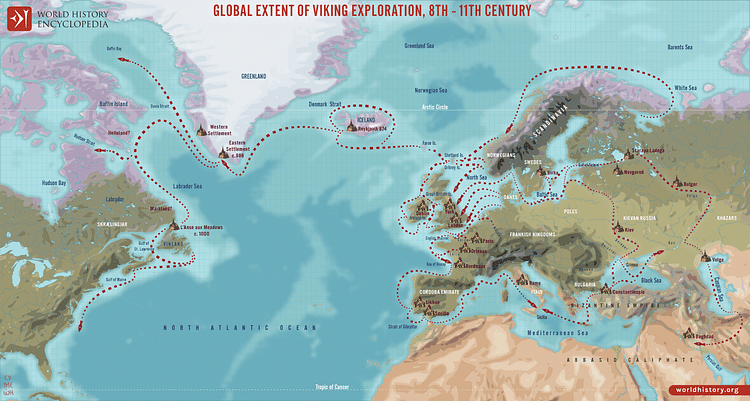
Kelly: And I guess writing a book which you have called the story of a founding myth with the word 'myth' in the title and then looking at these two stories, you are walking into a big battle. I am sure you wrote this knowing that it was not going to be happily received by everyone who reads it.
Gordon: By the time I started writing, I had a very clear idea of that, but it is all right. I am very thick-skinned.
Kelly: I was going to ask about some of the people that you have mentioned, just for people who may not be aware of them. Do you want to just go through who Leif the Lucky, and Erik the Red are?
Gordon: Sure! Erik the Red is the mythical head of a family, who may have existed. He was not a nice man. I think we might think of him as a serial killer. He was banished repeatedly for murder. He did not get on with his neighbours very well, and the story in the two sagas has him being banished in the first instance for three years, and he goes off to Greenland. He sets up a colony there and his son, Leif Erikson, also called Lucky not because he was lucky, but because the characteristic of luckiness is built into him as it were. It is not that he enjoyed good luck, it is a comment on his character. Whether he existed or not, I doubt. But he went off and discovered various places, one of which was Vinland. Vinland had wild grapes and self-sown wheat, and it was a great place. So, people have a good time identifying where the real Vinland is.
There are many nominations, as you can imagine. They are the principal characters. But the sagas also have Erik's wife, who became a Christian. There are foundations of a church in Greenland, the first church in the New World. That is confidently assigned to his wife, who almost certainly never existed, but let that not hamper us. There are four children, and they are all involved in the voyages in various ways. They are great stories, but their relationship to what actually happened is very difficult to say. You cannot tell what shards of memory might be embedded in any myth.
The one bit of evidence of contact is an arrowhead. It is now in the National Museum in Denmark. I have been to see it. It was found in a graveyard in Greenland, a graveyard that closed in about 1350. So, it is earlier than that. And the arrowhead is made of a kind of quartz and in a style that can be pinpointed to what is called the Point Revenge culture. One specific spot on the coast of Labrador.
They would go to Labrador, I assume, to collect timber because Greenland does not have much in the way of trees. And this Norseman may have brought the arrow back in his pocket, but it seems more likely given where it was found, that it came back in his skull. It is evidence of contact, but not of a very friendly kind, but that is who they are. They are sort of historical fiction, you just cannot tell what is true and what is not, but there is no hard evidence in them.
Kelly: I guess when you think about the sagas and popular Vikings you think there might have been a Bjorn, but it might have been eight different men, all named Bjorn and that is all being combined into one legendary character. Is it the same sort of thing?
Gordon: Well, there could have been. But the striking thing is, in Greenland, there has been a lot of good archaeology there. On some of the artefacts there are names written, and none of the names on artefacts uncovered by archaeologists in Greenland corresponds to any name in the sagas. One day someone might come up with a piece of wood that has Leif Erikson or Erik the Red on it, but at present, there is nothing. It is a curious story, the part that people do not know about is the Viking Age Greenland colonies that lasted for 500 years. They arrived in about 985, they disappear sometime in the middle of the 15th century. We do not know why. So, enter all kinds of daft theories.
There were 2000-3000 people. They spoke a distinctive form of Norse, and there was a vast stone cathedral. I visited the parish church; it has a choir loft. There were services in Latin, and all of this is happening in North America. It is not highly sophisticated. They are peasant farmers, but the church is there. There is a monastery, and a nunnery. It is a civilised kind of place. There is no awareness of this, nor any credit given to it by those that want the Norse to have come to America or, indeed, Canada. Greenland is written off, and that rather saddens me. It is a wonderful place in lots of ways. It has interesting Inuit histories, and indeed, other indigenous groups were there as well. It has a great Norse history, and yet there is no awareness of it in the popular imagination.

Kelly: That is so sad. Do you hope that this book will shed the light on Greenland a little bit, just reminding people how great it is and what there is there?
Gordon: Indeed! There is a wonderfully feisty sign in the National Museum in the capital – which is Nuuk – that says these colonists say that Greenland is part of Europe, but we, the Inuit, speak the same language as our cousins across in Canada, we have the same values. We share many aspects of our culture, and we are part of North America. The discoverer of North America, the European discoverer was not Leif the Lucky, who simply went to the mainland on a day trip, it was Erik the Red. That is the only place I have seen Erik the Red acknowledged. But anyhow, it is a feisty sign, and it is an important one because it is saying we are misconstrued. You are ignoring the indigenous point of view, which is a perfectly reasonable and utterly convincing one. It is not daft at all, and as soon as you read the sign, you know they are right. That side of it interests me very much, and that was new to me because I knew very little about Greenland. I find it a very rewarding field to work in.
Something that strikes me about the fake artefacts is that they often appear in areas of Scandinavian settlement in the United States and Canada. In other words, they are created to bolster an ethnic identity. And it is interesting, the Kensington Runestone, for example, that I described, appeared in a Scandinavian farming community in rural Minnesota. Scandinavians are now not hyphenated Americans, they are real Americans. But in the 19th century, they were a marginal group, and they were treated as yokels, as simple people by sophisticated New Englanders.
Kelly: It sounds like it is a brilliant book, and it is going to rock the popular view of America, the history of America, and the beliefs of Columbus versus the Norsemen.
Gordon: I simply want it to feed into the argument. It is, as you say, an argument that has not been made before. There may be faults in it, and the only way people can find out is to read it, but it certainly interested me.
Kelly: Thank you very much for joining me!
Gordon: You are very kind. Thank you very much.
